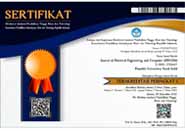Increasing the Effectiveness of Electricity-Generating Floors Through the Mechanical Energy of DC Generators
Authors (s)
(1) * Sagita Rochman
 (PGRI Adi Buana University Surabaya)
(PGRI Adi Buana University Surabaya) Indonesia
(2) Rasyida Shabihah Zukro Aini (PGRI Adi Buana University Surabaya)
Indonesia
(3) Mussafa Billah (PGRI Adi Buana University Surabaya)
Indonesia
(*) Corresponding Author
AbstractThe increasing electricity consumption of the Indonesian population requires renewable energy as an alternative to electricity generation supplies. Renewable energy can be formed through mechanical energy in its simplest form, namely in the form of a footrest. Generally, energy-harvesting floors that utilise human footsteps are designed with piezoelectric sensors. This sensor is responsible for converting mechanical energy into electrical energy. However, the power generated from piezoelectrics is only around 0.041 μW to 240.59 μW. So, in this study, an alternative design for a footstep floor is proposed capable of harvesting electrical energy using a DC generator. The proposed platform consists of a platform design that utilises the translational motion of the gears on the gear rack and is assisted by four springs surrounding the sides of the iron plate. Apart from that, the platform has a power management and storage system. Unlike controllers in general, solar charger controllers are used for charging (voltage and current in the accumulator) and flowing current to the load (lights). The subjects used in this floor test ranged from 20-100 kg. Compared to floors that use piezoelectrics, the results are that floors with DC generators experience an increase in power of around 0.62%. Hence, DC generators are more effective in harvesting electrical energy. |
Keywords
Full Text: PDF
Refbacks
- There are currently no refbacks.
Copyright (c) 2023 Sagita Rochman, Rasyida Shabihah Zukro Aini, Mussafa Billah









